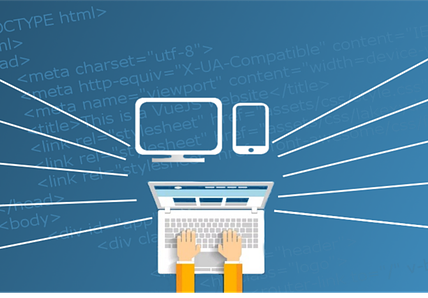How can our web applications run smoothly and effectively when utilizing different types of technology as a front-end and backend? Can React, a popular user interface library, be used in synergy with the scripting language PHP to develop web applications? Do the benefits of using both React and PHP in our applications outway the potential downfalls?
These are all important questions to consider when attempting to create a fully functioning web application in our current technological landscape. With more and more software components such as databases, libraries, and other frameworks consistently making their way into our projects, many developers are struggling to integrate and keep all the complex technologies in their projects working together harmoniously. There are a variety of web stacks to choose from, but the combination of React as a front-end and PHP as a backend has stood the test of time.
In this article, you will learn the fundamentals of using React and PHP together as part of an MVC (Model-View-Controller) web application. We will discuss why this stack has withstood the test of time and remains one of the most practical and popular choices for web applications. We will also explore tips for building React front-ends and PHP back-ends that integrate smoothly with no conflict.
Finally, we will look at what types of web applications benefit the most from this type of stack, and how our users reap the rewards of React and PHP working alongside each other.

Definitions of React Front-end with PHP Backend
React is a JavaScript library developed by Facebook, and is used for user interface (UI) development. It allows developers to create UIs quickly and easily, with a declarative programming style. React components can be written in pure JavaScript, or with a mixture of HTML, JavaScript, and other libraries. The combination of React and JavaScript provides developers with an elegant and efficient way of creating UIs. Front-end refers to the client side of an application; in other words, the code that runs in the user’s browser. The front-end typically interacts with the backend via APIs.
PHP (PHP: Hypertext Preprocessor) is a popular open source server-side scripting language. It is used to process data from web forms, as well as to create dynamic web applications. PHP code can be written in HTML or in its own syntax, which is then parsed by the web server. PHP includes built-in functions for database connections, mail handling, and more, which makes it a powerful and versatile language for web development.
React front-end and PHP back-end can be used together to create web applications. By using React to write the front-end code, developers have the advantage of creating UI code quickly and efficiently. The code can then be fed to the PHP backend, which can process it and generate the data needed for the application. This approach allows developers to create feature-rich applications with a minimal amount of code.
Using React Front-end and PHP Backend: What is Possible?
React Front-end & PHP Backend Integration
React is a JavaScript library popular in front-end development. It allows users to create small and complex user interfaces with reusability in mind. It works as a bridge to connect a user interface with the data stored. It is the perfect technology for creating powerful single-page applications.
On the other hand, PHP is a fast and simple server-side scripting language popularly used in web development today. It is preferred due to its flexibility and cost-effectiveness. Combining React and PHP may be a great way to develop a website or an application that requires high performance.
The integration of the two languages is made possible due to various JavaScript frameworks and libraries. Many libraries and frameworks like Next.js, React Router, Strapi provide a way to integrate React with PHP.
Benefits of React & PHP Integration
Integrating React and PHP can open up doors to create powerful websites and applications that can help businesses increase their online presence. Here are some of the biggest advantages of a React & PHP integration:
- It increases the performance of the website. React libraries reduces the amount of data transferred between server and client thus resulting in a faster website.
- React leverages PHP’s capabilities for simplifying the security of the website. It helps control access rights, protect authentication, and create secure APIs.
- It boosts the flexibility and scalability of the website. With React, users can create complex and detailed websites. Furthermore, React is also capable of working easily with both present and future technologies.
- It provides great responsiveness to the website. It allows creating interactive and flexible user interfaces that give perfect loading experiences to the users.
Depending on the use of a React & PHP integration, developers may also consider using different tools such as Webpack, Redux, Apollo, React Router, etc. These tools can help create great websites with high-end graphics and user experience. However, it is recommended that the developers gain some knowledge of React before deciding to use it with PHP to get the most out of the integration.
Unlocking Potential of React with PHP: A Guide
The Challenge of Integrating React and PHP
Do disparate front-end and back-end technologies challenge your ability to create dynamic applications? React, a JavaScript library powered by Facebook, is known for its ability to create robust user interfaces. On the other hand, PHP is a powerful server-side scripting language created by Rasmus Lerdorf. Is it possible to combine these web development beasts to create a system that syncs seamlessly?
Myriad Benefits of Integrating React and PHP
Integrating React with PHP can open up many possibilities. It allows developers to use their respective strengths to build rich web applications for a variety of purposes. It also helps eliminate the need to learn multiple languages, creating an environment where developers can focus their skills and time more efficiently. These advantages are just the tip of the iceberg when it comes to unlocking the potential of React-PHP integration.
Best Practices for React-PHP Integration
Putting together a React front-end to an existing PHP backend requires proper planning and execution. First, plan out the entire flow of interactions, such as routing, inputs, and data fetching on the front-end. On the back-end, set up backend code that will respond to the requests made from the React front-end. Set up a communication protocol between the two technologies, be it RESTful APIs, WebSocket, or another type of protocol. Once properly configured, debugging and optimization can be done for a complete application.
One way to ensure data exchange between the React front-end and the PHP backend is with AJAX calls. This provides smooth communication, updates, and data transfer during user interactions. It also prevents page reloads while incremental updates occur. Furthermore, utilize best practices in React, such as component-based architecture for scalability, dividing components up logically for extension and modification.
When considering React-PHP integration, developers should keep in mind ease of development, scalability, and maintenance. Proper planning, architecture selection, and communication protocols—along with choosing the right set of best practices—is key to developing an effective and robust React-PHP solution.
Exploring New Horizons: Combining React and PHP
Exploring New Horizons: Combining React and PHP
Developing web applications can be daunting; however, by combining React and PHP, it is possible to build quickly and securely. React is a popular JavaScript library used for creating highly interactive user interfaces, while PHP can be seen as a backend language that builds the necessary logic and connections between databases and applications. The combination of these tools has been gaining momentum in recent years, yet many developers are still uncertain about the benefits it provides.
The Benefits of React and PHP
The primary benefit of React and PHP is that it allows developers to create powerful web applications without the need to reinvent the wheel. By combining the two technologies, developers gain access to a wide array of modules, libraries, and technologies that can be used to create powerful applications. From small websites to larger projects, React and PHP provide a robust set of features that can be used to create an effective web application.
Additionally, React and PHP can provide a fast and secure development environment. React is fast and easy to learn, which makes it well-suited for building responsive websites and complex applications. On the other hand, PHP is extremely secure, meaning developers do not have to worry about potential security issues within their applications.
New Possibilities with React and PHP
React and PHP can be used in tandem to build a wide array of applications. From eCommerce sites to interactive web applications, these two technologies open up a world of possibilities.
For example, a React and PHP application can be used to create a single-page application for online stores. By utilizing React’s powerful components and routing capabilities, developers can build sleek, responsive user experiences that are fully customized to the user’s needs. Moreover, with PHP’s access to databases and other backend technologies, developers can ensure secure transactions and the reliability of data.
Another example of combining React and PHP is with content management systems. The combination of these two technologies can be used to quickly create blogs, build powerful websites, and provide users with a secure access to their data. By using React’s components, developers can ensure a well-structured content and maintain a high level of interactivity within the application. Furthermore, by leveraging PHP’s robust database access and security functions, developers can ensure that their content is safe, secure, and up-to-date.
Finally, React and PHP can be combined to build applications that use real-time data. By utilizing the powerful features of React, developers can ensure that their applications are responsive and update their content when it changes. Meanwhile, by leveraging PHP’s ability to interact with databases and other web technologies, developers can ensure that their applications are receiving accurate information and staying up-to-date.
By creating applications with React and PHP, developers open up a world of possibilities. From single-page applications to complex content management systems, there are numerous ways to take advantage of these two powerful technologies. The only question that remains is: How will you use this combination to explore new horizons?
Conclusion
Additionally, React and PHP can provide a fast and secure development environment. React is fast and easy to learn, which makes it well-suited for building responsive websites and complex applications. On the other hand, PHP is extremely secure, meaning developers do not have to worry about potential security issues within their applications.
New Possibilities with React and PHP
React and PHP can be used in tandem to build a wide array of applications. From eCommerce sites to interactive web applications, these two technologies open up a world of possibilities.
For example, a React and PHP application can be used to create a single-page application for online stores. By utilizing React’s powerful components and routing capabilities, developers can build sleek, responsive user experiences that are fully customized to the user’s needs. Moreover, with PHP’s access to databases and other backend technologies, developers can ensure secure transactions and the reliability of data.
Another example of combining React and PHP is with content management systems. The combination of these two technologies can be used to quickly create blogs, build powerful websites, and provide users with a secure access to their data. By using React’s components, developers can ensure a well-structured content and maintain a high level of interactivity within the application. Furthermore, by leveraging PHP’s robust database access and security functions, developers can ensure that their content is safe, secure, and up-to-date.
Finally, React and PHP can be combined to build applications that use real-time data. By utilizing the powerful features of React, developers can ensure that their applications are responsive and update their content when it changes. Meanwhile, by leveraging PHP’s ability to interact with databases and other web technologies, developers can ensure that their applications are receiving accurate information and staying up-to-date.
By creating applications with React and PHP, developers open up a world of possibilities. From single-page applications to complex content management systems, there are numerous ways to take advantage of these two powerful technologies. The only question that remains is: How will you use this combination to explore new horizons?
Conclusion
For example, a React and PHP application can be used to create a single-page application for online stores. By utilizing React’s powerful components and routing capabilities, developers can build sleek, responsive user experiences that are fully customized to the user’s needs. Moreover, with PHP’s access to databases and other backend technologies, developers can ensure secure transactions and the reliability of data.
Another example of combining React and PHP is with content management systems. The combination of these two technologies can be used to quickly create blogs, build powerful websites, and provide users with a secure access to their data. By using React’s components, developers can ensure a well-structured content and maintain a high level of interactivity within the application. Furthermore, by leveraging PHP’s robust database access and security functions, developers can ensure that their content is safe, secure, and up-to-date.
Finally, React and PHP can be combined to build applications that use real-time data. By utilizing the powerful features of React, developers can ensure that their applications are responsive and update their content when it changes. Meanwhile, by leveraging PHP’s ability to interact with databases and other web technologies, developers can ensure that their applications are receiving accurate information and staying up-to-date.
By creating applications with React and PHP, developers open up a world of possibilities. From single-page applications to complex content management systems, there are numerous ways to take advantage of these two powerful technologies. The only question that remains is: How will you use this combination to explore new horizons?
Conclusion
It’s a common question: is it possible to join together the power of a React-based front end with the simplicity of a PHP backend? The answer is a resounding yes. By combining the two technologies, developers can create sophisticated applications that leverage the capabilities of both platforms.
The suite of tools available for synchronizing React and PHP is vast, ranging from full integrated frameworks to custom-built solutions. Regardless of the approach taken, the potential to bring world-class user experiences to life is impressive. Of course, this potential is only unlocked with the right combination of expertise and creativity.
Are you looking to bring React and PHP together? Are you curious to see the amazing things that can be accomplished with the combination of these powerful technologies? Then be sure to follow this blog, as our team will be regularly releasing helpful tutorials and updates on the best methods for leveraging both technologies. Don’t miss out—stay tuned for the latest developments!
F.A.Q.
Q1: How can I connect React front-end with a PHP Backend?
A1: You can connect React front-end with PHP backend by using the Axios library. For example, Axios can be used to make HTTP requests to the server from the client-side and get a response from the server. Additionally, you can use long-polling or web sockets for real-time updates.
Q2: What other libraries can be used to connect React front-end with a PHP backend?
A2: There are a variety of libraries that can assist in connecting React front-end to a PHP backend. Some examples include the Fetch API, jQuery, and XMLHttpRequest. It is important to do research on which library best fits your project requirements.
Q3: How can I customize my React front-end and PHP back-end?
A3: You can customize your React front-end and PHP back-end to fit your needs. Customizing the look of your application through style sheets and adjusting functionality through different libraries or frameworks can help improve user experience. Additionally, writing custom code can be used to execute specific tasks.
Q4: Is a PHP backend necessary to use with React front-end?
A4: No, it is not necessary to use a PHP backend with React front-end if there is an alternative solution to meet your needs. For instance, Node.js is an example of an alternative technology that can be used for backend development.
Q5: What are the benefits of using React front-end with a PHP backend?
A5: React front-end can be used with a PHP backend to create a fast and efficient dynamic web application. It also provides easy access to third-party libraries that can be used for specific tasks. Furthermore, it offers a variety of security features for added protection.




